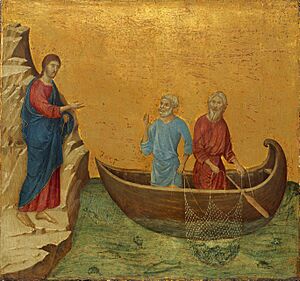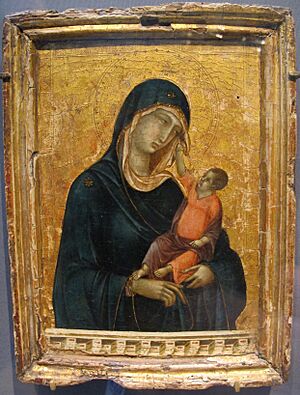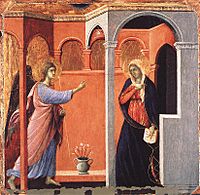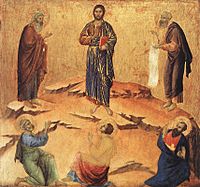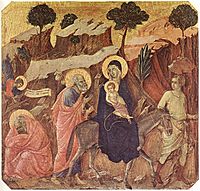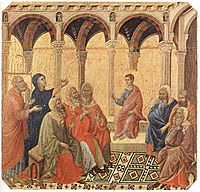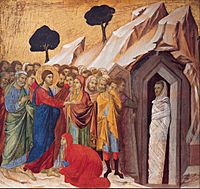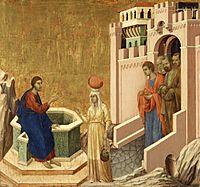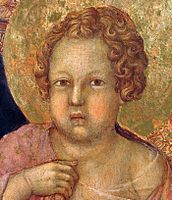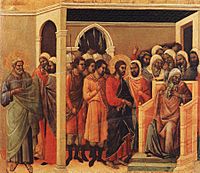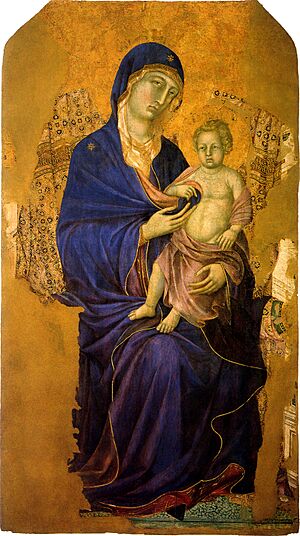Duccio facts for kids
Quick facts for kids
Duccio
|
|
|---|---|

Maestà detail of Madonna and Child on throne
|
|
| Born |
Duccio di Buoninsegna
c. 1255–1260 Siena, Republic of Siena
|
| Died | c. 1318–1319 (aged 57–64) Siena, Republic of Siena
|
| Known for | Painting |
|
Notable work
|
Rucellai Madonna (1285), Maestà (1308–1311) |
| Movement | Sienese school, Gothic Style |
Duccio di Buoninsegna (UK: /ˈduːtʃioʊ/ doo-CHEE-oh, Italian: [ˈduttʃo di ˌbwɔninˈseɲɲa]; c. 1255–1260 – c. 1318–1319) was an Italian painter who worked in Siena, Tuscany, during the late 1200s and early 1300s. He was hired for many important projects in government and religious buildings across Italy. Duccio is known as one of the greatest Italian painters of the Middle Ages. He helped create the painting styles of Trecento (the 1300s) and the Sienese school. He also played a big part in developing the Sienese Gothic style.
Contents
About Duccio's Life
Even though we don't know everything about Duccio, we have more records about him than many other Italian painters from his time. We know he was born and died in the city of Siena. He mostly worked in the area around Tuscany. Details about his early life and family are not very clear.
Historians have learned about Duccio by looking at old records. These records sometimes show when he had debts or had to pay fines. Some papers say he was married and had seven children. Because there are many mentions of him in these records, historians think he sometimes had trouble managing his money.
Another way to learn about Duccio is by studying the artworks we know he created. By looking at his painting style, the dates, and where his art was found, we can gather clues. Sometimes Duccio's name isn't mentioned in Siena's records for several years. This makes experts wonder if he might have traveled to places like Paris, Assisi, or Rome.
Despite any money troubles, Duccio's artistic talent was amazing. He became famous during his own lifetime. In the 1300s, Duccio was one of the most popular and innovative painters in Siena.
Duccio's Art Career
It's still a big mystery where Duccio studied art and who his teachers were. But by looking closely at his style, art experts have some ideas. Many believe he learned from Cimabue, another famous painter. Others think he might have traveled to Constantinople and learned directly from a master of Byzantine art.
We don't know much about his painting work before 1278. At that time, when he was about 23, records show he painted twelve account book covers. Duccio was active as a painter from around 1268 to 1311. However, only about 13 of his artworks are still around today.
Out of Duccio's surviving works, only two have exact dates. Both were big public projects:
- The "Rucellai Madonna" was ordered in April 1285 for a chapel in Santa Maria Novella in Florence. You can see it today at the Galleria degli Uffizi.
- The Maestà was ordered in 1308 for the main altar of Siena Cathedral. Duccio finished this huge artwork by June 1311.
Duccio's Painting Style
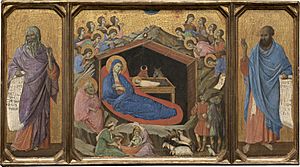
Duccio's known paintings are on wood panels. He used egg tempera paint, which is made by mixing colors with egg yolk. He also added beautiful gold leaf to his works. Unlike other artists of his time, Duccio was a master of tempera. He used it with great care and skill. We don't have clear proof that Duccio painted frescoes (paintings on wet plaster walls).
Duccio's style was a bit like Byzantine art. It used gold backgrounds and showed familiar religious scenes. However, Duccio also experimented and was different. He started to make the sharp lines of Byzantine art softer. He used "modeling," which means playing with light and dark colors. This made the figures look more rounded and three-dimensional, even under heavy clothes. Hands, faces, and feet in his paintings look more real.
Duccio's paintings are warm and inviting with their colors. His artworks have many tiny, delicate details. Sometimes, they even had jewels or fancy fabrics added to them. Duccio was also known for how he carefully arranged things in his paintings. He placed his characters in specific ways on purpose. In his "Rucellai Madonna" (around 1285), you can see all these special qualities.
Duccio was also one of the first painters to place figures inside buildings in his art. He started to explore how to show depth and space. He also paid close attention to emotions, which was new for painters at that time. His characters often interact tenderly with each other. For example, instead of just Christ and the Virgin Mary, it looks like a real mother and child. He started to make his paintings look more natural, but they still felt heavenly and inspiring. Duccio's figures seem to be from another world, with beautiful colors, soft hair, graceful poses, and clothes that ordinary people couldn't have.
He had a big influence on many other painters. The most famous ones include Simone Martini and the brothers Ambrogio and Pietro Lorenzetti.
Duccio's Followers
During his life, Duccio had many students or followers. We don't know if they were truly taught in his workshop or if they just copied his style. Many of these artists are unknown by name. We only know they were connected to Duccio because their art looks similar to his.
The first group of followers worked between about 1290 and 1320. These include artists known as the Master of Badia a Isola and the Master of Città di Castello.
Another group of followers worked between about 1300 and 1335. These include Segna di Bonaventura and Ugolino di Nerio. Some artists, like Segna di Bonaventura, worked during both periods.
A third group of artists started following Duccio's style several years after he died. This shows how much his painting impacted Siena and the whole region of Tuscany. These artists worked between about 1330 and 1350. They include Segna di Bonaventura's sons, Niccolò di Segna and Francesco di Segna.
Some artists were so influenced by Duccio that their works look very similar to his. This includes the Master of Badia a Isola, Ugolino di Nerio, and Segna di Bonaventura and his sons. Other artists were also influenced by different art styles. For example, the Aringhieri Master showed influences from Giotto, another famous painter.
The cases of Simone Martini and Pietro Lorenzetti are a bit different. Both artists painted works that show some influence from Duccio. Simone Martini's work shows this from about 1305, and Pietro Lorenzetti's from about 1310. However, from the very beginning, their art also had its own unique features. Later, they developed their own styles completely. This made them famous artists in their own right, much more than just followers of Duccio.
Gallery
-
Christ before Caiaphas
Known Surviving Works
Here are some of Duccio's artworks that are still around today:
- Madonna with Child – At the Museo d'Arte Sacra della Val d'Arbia, Buonconvento, near Siena.
- Gualino Madonna – At the Galleria Sabauda, Turin.
- Madonna with Child and two Angels (also called the Crevole Madonna; c. 1280) – At the Museo dell'Opera Metropolitana, Siena.
- Madonna with Child enthroned and six Angels (c. 1285) – Also known as the Rucellai Madonna – At the Galleria degli Uffizi, Florence.
- Crucifix – In the Odescalchi Collection, Rome.
- Crucifix (Grosseto) (1289) – In the Church of San Francesco, Grosseto.
- Madonna of the Franciscans (c. 1300) – At the Pinacoteca Nazionale, Siena.
- Triptych: Crucifixion and other Scenes c. 1302–08 – In the Royal Collection Trust.
- Assumption and Crowning of the Virgin – A stained glass window at Siena Cathedral.
- Maestà – At the Museum of Fine Arts Bern, Switzerland.
- Madonna and Child – At the Metropolitan Museum of Art, New York.
- Madonna with Child and six Angels – At the Galleria Nazionale dell'Umbria, Perugia.
- Polyptych: Madonna and Child with Saints (also known as Dossale no. 28; c. 1305) – At the Pinacoteca Nazionale, Siena.
- Polyptych no. 47: Madonna and Child with Saints – At the Pinacoteca Nazionale, Siena.
- The Surrender of the Castle of Giuncarico – A fresco at the Palazzo Pubblico, Siena.
- Maestà with Episodes from Christ's Passion – At Massa Marittima Cathedral, Italy.
- Small Triptych: Flagellation of Christ; Crucifixion with Angels; Deposition in the Tomb – In the Società di Esecutori di Pie Deposizioni, Siena.
- Small Triptych: Madonna and Child with four Angels, Saints Dominic, Agnes and seven Prophets – At The National Gallery, London.
- Portable Altarpiece: Crucifixion with Christ blessing; St Nicholas; St Gregory – At the Museum of Fine Arts, Boston, United States.
- Small Triptych: Crucifixion with Angels; Annunciation and Madonna with Child and Angels; Stigmata of St Francis with Madonna and Christ enthroned – In the UK Royal Collection.
- Maestá (Madonna with Child Enthroned and Twenty Angels and Nineteen Saints) – At the Museo dell'Opera del Duomo, Siena.
- Maestà (The Temptation of Christ on the Mountain) – At The Frick Collection, New York.
- The Crucifixion (c.1315) – At the New-York Historical Society, New York.
See also
 In Spanish: Duccio para niños
In Spanish: Duccio para niños


